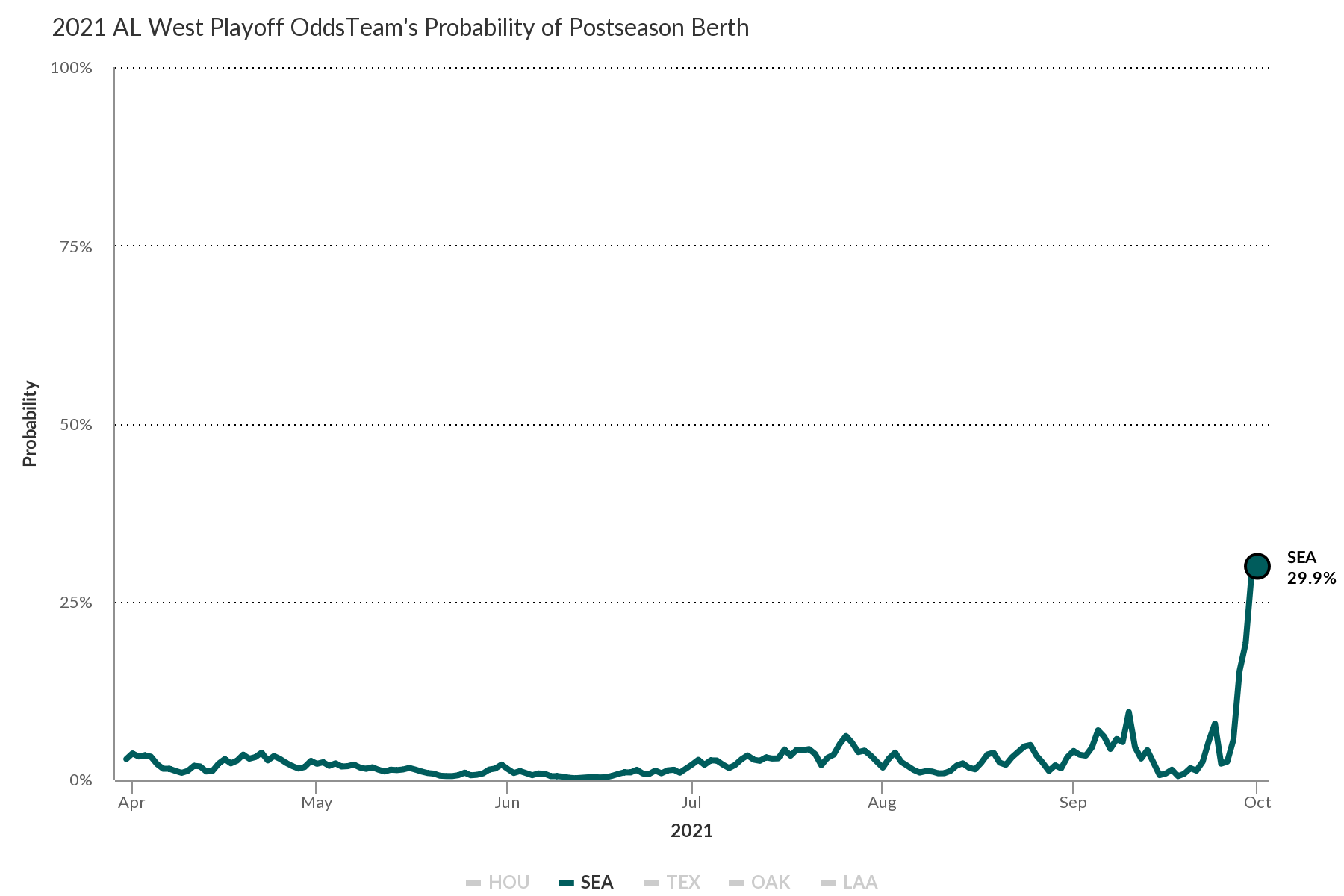Quick Sunday update. The Yankees lost on Saturday, furthering the potential for chaos, and the four-way tie is an increased possibility, at 6.5%. The chances of bonus baseball overall now stand at 57.6%. Good news for us and good news for the Rays, who will play one of these four teams later this week. It’s not something that’s captured in projections, but it’s interesting that if the Rays go full B-team, it reduces the chances of a tie, and as a result, a slight reprieve for the team they eventually play. Jameson Taillon is back in as the starter and Joan Adon looks to be Washington’s starter, which is to Boston’s benefit according to the projections.
The NL West remains unresolved, but simple: if the Dodgers win and the Giants lose, they play a tiebreak game. ZiPS has a 19.8% chance of a tiebreaker game, with the overall division as San Franciso 90.0%, Los Angeles 10.0%. Freddy Peralta is being held back for the playoffs with Brett Anderson going today. It makes sense too; it’s in Milwaukee’s interest to leave one of these teams more susceptible to getting knocked out of the playoffs by the Cardinals later this week.
ZiPS Playoff Drive Projections – AL Wild Card
| Day |
Home Team |
Starter |
Road Team |
Road Starter |
Home Team Wins |
Road Team Wins |
| 10/3 |
Blue Jays |
Hyun Jin Ryu |
Orioles |
Bruce Zimmermann |
65.7% |
34.3% |
| 10/3 |
Nationals |
Joan Adon |
Red Sox |
Chris Sale |
40.1% |
59.9% |
| 10/3 |
Yankees |
Jameson Taillon |
Rays |
Michael Wacha |
48.2% |
51.8% |
| 10/3 |
Mariners |
Tyler Anderson |
Angels |
Reid Detmers |
47.7% |
52.3% |
ZiPS Playoff Drive Projections – AL Wild Card Standings
| Team |
Wild Card 1 |
Wild Card 2 |
Playoffs |
| Boston |
52.4% |
32.4% |
84.8% |
| New York |
40.9% |
38.0% |
78.8% |
| Toronto |
3.8% |
17.7% |
21.5% |
| Seattle |
3.0% |
11.8% |
14.8% |
ZiPS Playoff Drive Projections – Changes in Playoff Projections
| Scenario |
BOS |
NYA |
TOR |
SEA |
| Boston Beats Washington on Sunday |
15.2% |
-2.8% |
-7.2% |
-5.2% |
| Baltimore Beats Toronto on Sunday |
7.1% |
10.6% |
-21.5% |
3.8% |
| Los Angeles Beats Seattle on Sunday |
5.0% |
6.3% |
3.5% |
-14.8% |
| Tampa Bay Beats New York on Sunday |
2.7% |
-20.0% |
10.3% |
7.0% |
| New York Beats Tampa Bay on Sunday |
-2.9% |
21.1% |
-11.1% |
-7.1% |
| Toronto Beats Baltimore on Sunday |
-4.0% |
-5.1% |
11.2% |
-2.1% |
| Seattle Beats Los Angeles on Sunday |
-5.2% |
-7.0% |
-3.8% |
16.0% |
| Washington Beats Boston on Sunday |
-23.7% |
4.2% |
11.5% |
8.0% |
ZiPS Playoff Drive Projections – Changes in Playoff Projections
| Game |
Leverage |
| New York vs. Tampa Bay on Sunday |
0.41 |
| Washington vs. Boston on Sunday |
0.39 |
| Toronto vs. Baltimore on Sunday |
0.33 |
| Seattle vs. Los Angeles on Sunday |
0.31 |
ZiPS Playoff Drive Projections – NL West
| Day |
Home Team |
Starter |
Road Team |
Road Starter |
Home Team Wins |
Road Team Wins |
| 10/3 |
Dodgers |
Walker Buehler |
Brewers |
Brett Anderson |
60.0% |
40.0% |
| 10/3 |
Giants |
Logan Webb |
Padres |
Reiss Knehr |
66.7% |
33.3% |
| 10/4 |
Giants |
Alex Wood |
Dodgers |
Max Scherzer |
53.3% |
46.7% |
===
Below you’ll find today’s ZiPS stretch run update. For details on just what’s going on here, please refer to my original article describing all these mathnanigans.
American League Wild Card
The Yankees and their bats were largely quiet against the Rays on Friday, but they still basically control their own destiny as the team in the first Wild Card spot, albeit the one with by far the toughest opposition. The Blue Jays fended off a late-inning Baltimore rally and held on to the win, but the Red Sox winning was just as damaging to Toronto’s playoff hopes as the Jays’ win was helpful. Toronto’s still one-in-five to make the postseason, but needs some help now; since the Blue Jays are already assumed to be strongly favored to beat the Orioles, they get an even larger boost from a Nationals win. Read the rest of this entry »




